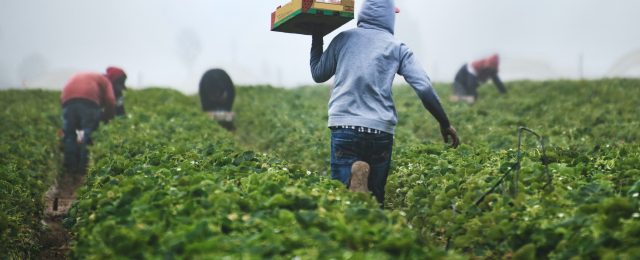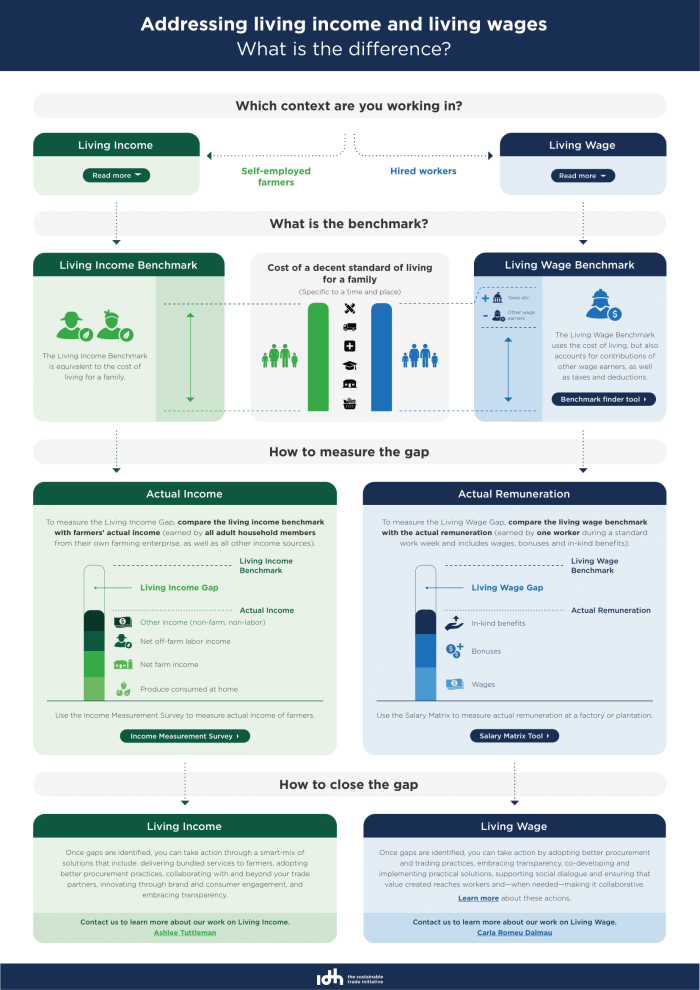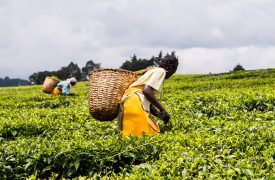The way towards living wages and incomes in the food system

Written by Laura Taal (IDH) and Annabel Mulder (WBA)
Not only is food a necessity of life, it is also a source of livelihoods for millions. However, many people working in the agricultural sector struggle to get by and two-thirds of the global population living below the poverty line are farmers, workers in agriculture and their dependants. The sector is characterised by informal, seasonal and underpaid employment and in many situations the pay received for a standard work week or the sale of agricultural products is not sufficient to meet the requirements for a decent quality of life.
As a global community, we need to do more to ensure that all farmers, fishermen and -women and workers in the sector receive a pay that is sufficient to afford a decent standard of living. In other words, a living wage or living income. The World Benchmarking Alliance (WBA) and IDH – The Sustainable Trade Initiative partner together to provide those interested in addressing the issue of living wages and incomes in their supply chains with practical tools, such as IDH’s Roadmap to Living Income and the Roadmap to Living Wages. WBA’s benchmarks create transparency and accountability by tracking company’s progress on addressing living wage and living income.
Results from the 2021 Food and Agriculture Benchmark demonstrate that more and more companies are addressing the issue. ”The momentum to close the living wage and living income gap is building”, says also Daan Wensing, CEO of IDH the Sustainable Trade Initiative. Nevertheless, over 90% of companies lack concrete action at scale to effectively address living wage and income gaps. So, how can the sector move towards ensuring a decent standard of living for workers and farmers?
What are living wages and living incomes?
The concepts of living wage and living income are both about ensuring a decent standard of living for households. The concept of a living wage is applicable in the context of hired workers, such as farm or factory workers, who receive a salary for their labour. Living income, on the other hand, refers to situations of self-employment and is applicable to farmers, fishermen and -women and small-scale producers.
There are different definitions of living wage and income, but the basic idea is that the pay or income received should be sufficient to cover basic needs and some discretionary income for a family. Basic needs include housing, food and transportation, but also education and medical costs. Some discretionary income is necessary for unexpected events. Because the average size of a family and the cost of living differs per geography, living wage and income vary around the world.
Steps towards ensuring a living wage and living income
1. Identify the living wage or income level
The first step for companies committed to ensuring a decent standard of living for agricultural workers and farmers is to identify the living wage and living income in the regions of interest. These are often referred to as a living wage or living income benchmarks. For living wage benchmarks, companies can choose a benchmark from a Living Wage Benchmark Methodology recognized by IDH. There are several organisations that calculate living wage and income benchmarks for different locations from which companies can retrieve this data.
Examples for living wage include the Global Living Wage Coalition, Fair Wage Network and WageIndicator. The different benchmark methodologies recognized by IDH are explained here. IDH has also published a Living Wage Identifier Tool, which helps companies find credible living wage benchmarks from every country they source from. By searching a specific region, the user will have access to a list of the benchmarks available. For living income benchmarks, visit the ALIGN platform from Hivos and Fairfood.
2. Measure living wage or income gaps
After living wage or living income benchmarks have been identified, companies can compare these with current levels to identify the gap between actual remuneration or income received and the cost of living for a family in a certain location. For living wages, the IDH Salary Matrix is a useful tool that provides insight on several indicators, for example, the average size of the gap for workers earning less than a living wage and the number of workers below a living wage. For living incomes, companies can use the IDH Income Measurement Surveys to guide data collection on smallholder households’ total actual income in cocoa and coffee through farmer surveys.

3. Verifying calculations
The third step to addressing living wage in a supply chain is to verify the living wage gaps. While the Salary Matrix serves as a useful reference, the desired scenario is that the results generated can be verified through third-party auditing by auditing bodies and certification schemes that have living wage requirements in their standards. Currently, several programs are strengthening their certification standards and auditing procedures to include living wage related requirements. To support that process, IDH developed recommended guidelines for verifying living wage gaps through third-party auditing and the corresponding base report, which serves as the physical evidence for third-party verification of living wage gaps. Guidelines have also been developed for first- and second-party auditors. Similarly, companies should strive to verify living income gap calculations. Although no tools or audits are available for this yet, learnings can be drawn from those that have established credible benchmarks, such as Fairtrade International.
4. Close the gap
Once gaps are identified and verified, companies can take action on living wages. In their own operations, companies can raise wages or set targets to do so. In their supply chain, buying companies can support the payment of living wage by including requirements in supplier contracts, adopting better procurement and trading practices, and by supporting suppliers to develop and implement practical solutions that can link to increased remuneration, such as enhancing productivity, profitability, quality and by supporting social dialogue in both their operations and in their supply chain. In addition, in most supply chains collaboration among stakeholders (including suppliers; traders; retailers; governments; trade unions; civil society; certification schemes; financial institutions) will be a necessary step to achieve living wages.
To address the identified living income gaps, companies should use a smart mix of interventions to address different income drivers. These include delivering bundled services to farmers, improving procurement practices, collaborating with and beyond trade partners, innovating through brand and consumer engagement, investing in traceability and transparency, and supporting sector management and the strengthening of the enabling environment. Alongside action, it is imperative to track results and continuously improve the intervention and partnership strategy to ensure income gaps close.
5. Sharing learnings
When companies communicate about their actions and challenges towards ensuring living wages and incomes, they create transparency and can act as catalysts for further change. Good practices can serve as an example and roadmap for others. They can set the bar and incentivise more companies to start this journey. In addition, good practice examples allow investors, consumers, worker organizations and other stakeholders to hold laggards accountable for their lack of action. Similarly, by communicating about their challenges towards closing living wage and income gaps, companies can learn from each other and improve their practices over time. IDH has a selection of best practices of frontrunner companies on living wage available on its website.

Food And Agriculture Benchmark
Results from the Food and Agriculture Benchmark
WBA’s 2021 Food and Agriculture Benchmark assessed how the 350 most influential food and agriculture companies contribute to achieving the Sustainable Development Goals. The methodology addresses topics related to governance and strategy, environment, nutrition and social inclusion, and includes a focus on living wage and living income.
Our research shows that companies are increasingly addressing living wage and living income in their operations and supply chain, with many examples of pilot programs and activities. However, there is a lack of impact at scale. Just 30 out of the 350 companies assessed demonstrate that they have taken concrete action to support living wages in their operations or supply chains by setting targets to pay living wages in their own operations, disclosing how living wages are calculated, and supporting the payment of living wages in their supply chains. Only two companies, Musim Mas and Unilever, demonstrate they have achieved paying a living wage across their operations in addition to having set targets to do so in their supply chains or including living wage requirements in supplier contracts.
With regards to improving income, the benchmark assessed how companies are supporting the productivity and resilience of farmers and fishers. We see that 54% of companies in scope have a commitment or disclose evidence of activities to support these groups. While this is an important first step, the benchmark found a lack of reporting on the impacts of these activities. This makes it difficult to determine how farmers and fishermen and -women benefit and whether they are moving towards earning a living income. Companies therefore have an opportunity to measure the impact of their support activities and communicate these externally, as well as to increase the scope of their programs.
Momentum to close the living wage and income gaps is building, with more and more companies recognising the issue and taking action. By setting targets to act at scale, disclosing commitments and the impact of their activities, companies will work towards living wage and income, as well as improve their benchmark performance. As emphasised by Daan Wensing, ”we understand this asks for courageous action, as this path is not yet streamlined. Yet, we believe this is the only way forward to close gaps to living wages and incomes to transform the lives of workers and farmers.”


